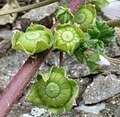Top Qs
Timeline
Chat
Perspective
Malva neglecta
Plant species in the mallow family From Wikipedia, the free encyclopedia
Remove ads
Malva neglecta is a species of plant of the family Malvaceae, native to most of the Old World except sub-Saharan Africa. It is an annual growing to 0.6 m (2 ft). It is known as common mallow in the United States and also as buttonweed, cheeseplant, cheeseweed, dwarf mallow, and roundleaf mallow.[2] This plant is often consumed as a food, with its leaves, stalks and seed all being considered edible.[3][4][5] This is especially true of the seeds, which contain 21% protein and 15.2% fat.[6]
Remove ads
Description
Dwarf mallow is a prostrate, downy, annual herbaceous plant, growing to approximately 60 cm. The leaves are alternate with long, strongly channeled petioles (up to 12 cm) and narrowly triangular stipules. Each leaf is reniform or with 5–7 shallow lobes, the basal leaves are 3–7 cm. The flowers are single-stalked and occur in clusters of 2–5 in the leaf axils. The flower stalks are shorter than the leaf stalks, with the leaves partially obscuring the flowers. The fruits are schizocarps, which split into 10–12 mericarps (nutlets) and are smooth and hairy.[7][8]
Remove ads
Distribution
- Native
- Palearctic:
- Macaronesia: Canary Islands
- Northern Africa: Algeria, Morocco
- Arabian Peninsula: Saudi Arabia
- Western Asia: Afghanistan, Cyprus, Sinai, Iran, Iraq, Israel, Jordan, Lebanon, Palestinian Territories, Syria, Turkey
- Caucasus: Armenia, Azerbaijan, Georgia
- Soviet Middle Asia: Kazakhstan, Kyrgyzstan, Tajikistan, Turkmenistan, Uzbekistan
- Mongolia: Mongolia
- China: Xinjiang
- Indian Subcontinent: India, Pakistan
- Northern Europe: Denmark, Ireland, Norway, Sweden, United Kingdom
- Middle Europe: Austria, Belgium, Czech Republic, Germany, Hungary, Netherlands, Poland, Slovakia, Switzerland
- Southeastern Europe: Albania, Bosnia and Herzegovina, Bulgaria, Croatia, Greece, Italy, Montenegro, North Macedonia, Sardinia, Serbia, Slovenia, Romania,
- Southwestern Europe: France, Portugal, Spain
Source:[9]
Remove ads
Uses
Leaves and young seeds can be eaten raw or cooked. Mature seeds should be cooked like rice or grains.[10]
Botanical gallery
- Plant spreads along ground, leaves not large, leaves fairly uniform size (Antalya)
- Spreading on rocks, similarly (Edinburgh)
- Flowers, fruits and leaves
- Flowers, fruits and leaves, closer
- Flowers can be pink with bold veins or may be pale
- Paler form, hairs (visible) in centre at petal stalks
- Flower much larger than calyx, green calyx with 5 broad parts, epicalyx at base formed of 3 narrow strips
- Flowers may have long to very long stalks
- Fruits
- Fruits
- Fruiting undersides, showing epicalyx of 3 narrow strips
- Flowers and fruits from side showing the features above, stalks reasonably long
- Hairs a mixture of stellate (star-like) and simple
- Hairs a mixture of stellate (star-like) and simple
- Leaf
- Leaf underside
- Leaf underside
Remove ads
References
External links
Wikiwand - on
Seamless Wikipedia browsing. On steroids.
Remove ads


















